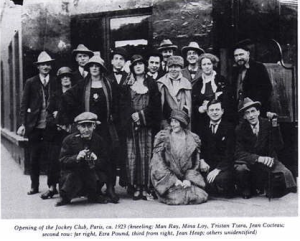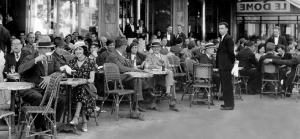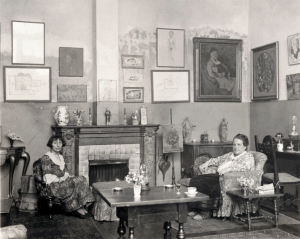By Margueritte Peterson
Once upon a time, there was the Roaring 20s. There was plenty of jazz, shorter skirts and illegal booze all over the place.
The End.
Just kidding!
I could never stop a 20s blog with that – not when it is one of my favorite periods! (In an “I would live then only if I could live as Dorothy Parker” kind of way.) The 1920s saw an explosion of color and creativity all over the world, but no place more so than one of Vic’s favorite places in the world… Paris, France. Paris was the heart of the avant-garde movement – the center of the bohemian creative culture – and therefore it drew artists, authors and forward thinkers from all over the world… especially the United States.
It was Gertrude Stein (today is, by the way, the 70th anniversary of her death), prominent literary “hostess” and celebrated figurehead of the 20s literary & artistic movement in Paris, who first thought up an expression for these expatriates living in Paris – “The Lost Generation.” It came to be a well-known phrase and widely used throughout those considering themselves part of this movement. Some of those people included members of any number of artistic circles at the time – Modernists, Dadaists, Expressionists, Surrealists, Cubists… all could be found in Stein’s sitting room at one time or another, asking her impression of their paintings, their films or their chapters. Today we’d like to look at some of the members of this “Lost Generation!”
The British Library hit the nail on the head in its online publication on the American writers living in Paris in the 20s when they said that “On the face of it, the sobriquet of ‘Lost Generation’ seems an odd collective description for a group of writers and artists who were among the brightest flowering of American literary talent yet to emerge on the international stage.” A very true statement – as “Lost Generation” implies a group of people either not recognized for what they are, or without a true home. Both of these statements were not true – they were very much welcome in Paris (as far as “homes” go) and they were recognized as the (often scandalous) trendsetters that they were.

Some members of the Paris culture captured together… James Joyce, Ezra Pound, Andre Breton & Tristan Tzara some of those pictured!
Stein was one of the first to emerge on the Paris scene, moving there in 1904 with her brother Leo (who hoped to pursue art) after abandoning her medical studies at Johns Hopkins University. Stein was there at the perfect moment – just in time to see every expatriate from all over the world move to Paris to pursue alternative lifestyles! Edith Wharton (one you perhaps did not know was part of the expatriate scene) arrived in 1906 and later on wrote The Age of Innocence in Paris. In the 1910s more and more artists and authors relocated, including Tristan Tzara (the Romanian-born father of Dadaism) and Andre Breton (French-born father of the shocking Surrealist movement and friend/student of Tristan Tzara). In the 1920s an influx of American born authors arrived, including many of the most well-known authors to date! F. Scott Fitzgerald & Ernest Hemingway were staples during the Parisian Roaring 20s (Hemingway used to have Stein proofread and edit his work – did you know that?) both setting several novels in this wild and artistic era. Other authors included James Joyce (Sylvia Beach of the Shakespeare & Co. Bookshop first published his novel Ulysses when no one else would), Sherwood Anderson, John Steinbeck, William Faulkner, poet Ezra Pound, visionary author Franz Kafka, poet and author T. S. Eliot were all prominent figures in the 1920s. The 1930s would also prove to be an illustrative time for authors in Paris as writers like Henry Miller and Anais Nin joined the circle and offered their own unique and remarkable literary talents to the world.
And this is just the authors! Artists included many of the real “greats” such as Picasso, Modigliani, Braque, Cocteau and Duchamp, music geniuses like Igor Stravinsky and Erik Satie were worshipped in parallel next to Cole Porter! This was truly a time of greatness – so much in every field contained in one city. The most striking certainty of this “Lost Generation”, however, is that despite their wild and tumultuous lifestyles, constant partying and detestation of the restrictions and constraints demanded of Victorian and early 20th century life, their work (in all aspects – writing, art and music) shows an astonishing range of depth, profoundness, clarity and sincerity not often found in one sitting.




